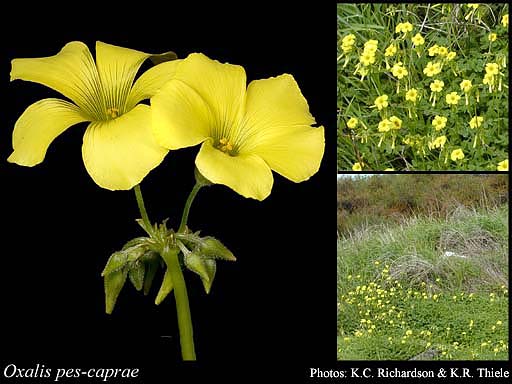- Reference
- Sp.Pl. [Linnaeus] 1:434 (1753)
- Conservation Code
- Not threatened
- Naturalised Status
- Alien to Western Australia
- Name Status
- Current
Bulbaceous and rhizomatous, perennial, herb, 0.1-0.3 m high. Fl. yellow, Jun to Oct. A common weed.







Distribution
- IBRA Regions
- Avon Wheatbelt, Coolgardie, Esperance Plains, Geraldton Sandplains, Jarrah Forest, Mallee, Swan Coastal Plain, Warren, Yalgoo.
- IBRA Subregions
- Eastern Goldfield, Fitzgerald, Geraldton Hills, Katanning, Merredin, Northern Jarrah Forest, Perth, Southern Jarrah Forest, Tallering, Warren, Western Mallee.
- IMCRA Regions
- Central West Coast, Leeuwin-Naturaliste, WA South Coast.
- Local Government Areas (LGAs)
- Albany, Armadale, Augusta Margaret River, Bridgetown-Greenbushes, Bruce Rock, Busselton, Cambridge, Capel, Cockburn, Cottesloe, Cunderdin, Dalwallinu, Dundas, Gnowangerup, Gosnells, Greater Geraldton, Harvey, Irwin, Kalamunda, Kalgoorlie-Boulder, Kondinin, Koorda, Mandurah, Manjimup, Melville, Moora, Mount Marshall, Murray, Narrogin, Nedlands, Northampton, Perth, Pingelly, Plantagenet, Quairading, Ravensthorpe, Serpentine-Jarrahdale, Shark Bay, South Perth, Stirling, Swan, Wanneroo, Waroona, Yalgoo.
Management Notes (for the Swan NRM Region)
Alternative Names. Sour Grass.
General Biology. Growth form. Geophyte. Life form. Annually renewed bulb. Reproduction. Bulbils. Dispersal. Soil, birds. Fire response. Generally survives fire.
Notes. In South Africa Oxalis pes-caprae is represented by diploid and tetraploid races. The short styled, sterile pentaploid race reported as invasive elsewhere is apparently uncommon in South Africa. Throughout most of its invasive range O. pes-caprae reproduces asexually by bulbils, rarely setting seed. Prefers disturbed sites. Some evidence it influences soil phosporous cycling. Soil disturbance can greatly enhance invasion.
Additional information. Origin. South Africa.
Suggested method of management and control. Spot spray metsulfuron methyl 0.2 g/15 L + Pulse®, or 1% glyphosate. Apply at bulb exhaustion, generally just on flowering. Exercise care if manually removing as physical removal can result in spread of bulbils. Read the manufacturers' labels and material safety data sheets before using herbicides. For further information consult the Australian Pesticides and Veterinary Medicines Authority to determine the status of permits for your situation or state.
Management Calendar
| Calendar Type | Jan | Feb | Mar | Apr | May | Jun | Jul | Aug | Sep | Oct | Nov | Dec | Comments |
|---|---|---|---|---|---|---|---|---|---|---|---|---|---|
| Dormant | Y | Y | Y | Y | Y | ||||||||
| Active Growth | Y | Y | Y | Y | Y | Y | Y | ||||||
| Flowering | Y | Y | Y | Y | |||||||||
| Optimum Treatment | Y | Y |
Legend: Y = Yes, regularly, O = Occasionally, U = Uncertain, referred by others but not confirmed.
References
- Benson, D. & McDougall, L. (1999) Ecology of Sydney Plant Species Part 7a, Dicotyledon families Nyctaginaceae to Primulaceae. Cunninghamia, 6 (2): 403-441.
- Brooks, K. (2001) Managing weeds in bushland: Soursob, Fingerleaf and Four oclock (Oxalis pes-caprae, O.glabra and O.purpurea). Environmental Weeds Action Network URL: http://www.environmentalweedsactionnetwork.org.au/ - Accessed December 2007.
- Brown, K. & Brooks, K. (2002) Bushland Weeds: A Practical Guide to their Management. Environmental Weeds Action Network, Greenwood.
- Harden, G.J. (ed.) (1990-93) Flora of New South Wales Vols. 1 to 4. New South Wales University Press, Kensington.
- Hussey, B.M.J., Keighery, G.J., Dodd, J., Lloyd, S.G. & Cousens, R.D. (2007) Western Weeds. A guide to the weeds of Western Australia. 2nd Edition. The Plant Protection Society of Western Australia, Victoria Park.
- Ornduff, R. (1986) The origin of weediness in Oxalis pes-caprae. American Journal of Botany, 73 (5): 779-780.
- Ornduff, R. (1987) Reproductive systems and chromosome races of Oxalis pes-caprae L. and their bearing on the genesis of a noxious weed. Annals of the Missouri Botanical Garden, 74 (1): 79-84.
- Parsons, W.T. & Cuthbertson, E.G. (2001) Noxious weeds of Australia. 2nd Edition. CSIRO Publishing, Collingwood.
- Peirce, J.R. (1998) Oxalis pes-caprae L. In Biology of Australian weeds, Vol. 2 (eds. F.D. Panetta, R.H. Groves, & R.C.H. Shepherd). R.G. & F.J. Richardson, Melbourne.
- Sala, A., Verdaguer, D. & Vilà, M. (2007) Sensitivity of the invasive geophyte Oxalis pes-caprae to nutrient availability and competition. Annals of Botany, 99 (4): 637.
- Verdaguer, D., Sala, A. & Vilà, M. (2010) Effect of environmental factors and bulb mass on the invasive geophyte Oxalis pes-caprae development. Acta Oecologica, 36 (1): 92.